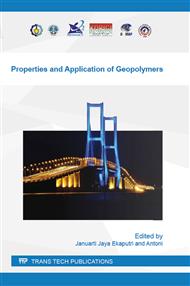[1]
M. Zhang, H. Guo, T. El-Korchi, G. Zhang and M. Tao, Construction and Building Materials Vol. 47 (2013), p.1468.
Google Scholar
[2]
E.J. Den Haan, in: Recent Advance in Soft Soil Engineering, edited by Huat & Bahia, Kuching, Sarawak (1997), in press.
Google Scholar
[3]
N. Cristelo, S. Glendinning, T. Miranda, D. Oliveira, Silva, R., Construction and Building Materials Vol. 36 (2012), p.727.
Google Scholar
[4]
O.S. Olaniyan, R.A. Olaoye, O.M. Okeyinka, D.B. Olaniyan, Internal Journal of Civil & Environment Engineering IJCEE-IJENS Vol. 11 (2011), p.6.
Google Scholar
[5]
J. Davidovits, Journal of Materials Education Vol. 16 (1994), p.91.
Google Scholar
[6]
J. Davidovits, Journal of Thermal Analysis Vol. 35 (1989), p.429.
Google Scholar
[7]
H. Xu, J.S.J. Van Deventer, International Journal of Mineral Processing Vol. 59 (2000), p.247.
Google Scholar
[8]
K., Komnitsas, D. Zaharaki, Minerals Engineering Vol. 20 (2007), p.1261.
Google Scholar
[9]
P. Duxson, J.L. Provis, G. C. Lukey, J.S.J. van Deventer, Cement and Concrete Research Vol. 37 (2007), p.1590.
DOI: 10.1016/j.cemconres.2007.08.018
Google Scholar
[10]
P. Chindaprasirt, T. Chareerat, V. Sirivivatnanon, Cement & Concrete Composites Vol. 29 (2007), p.224.
DOI: 10.1016/j.cemconcomp.2006.11.002
Google Scholar
[11]
R. Cioffi, L. Maffucci, L. Santoro, Resources Conservation and Recycling Vol. 40 (2003), p.27.
Google Scholar
[12]
N. Cristelo, S. Glendinning, L. Fernandes, A. T. Pinto, Acta Geotechnica (2013), p.1.
Google Scholar
[13]
R. Dayakar Babu, K. Ramu, S. Durga Prasad, K Ashok Kumar, Proceedings of Indian Geotechnical Conference (2013).
Google Scholar
[14]
J.D. McKinley, H. R. Thomas, K.P. Williams, J.M. Reid, Engineering Geology Vol 60 (2001), p.181.
Google Scholar
[15]
IAEG (1981). Commission on Engineering Geological Mapping.
Google Scholar
[16]
Britis Standards Instituition (1990). Part 2, Classification tests, BS1377, London.
Google Scholar
[17]
A. Marto, N. Latifi, H. Sohaei, Electronic Journal of Geotechnical Engineering Vol 18 (2013), p.521.
Google Scholar
[18]
W.I. Wan Mastura, A.M. Mustafa Al Bakri, V.S. Andrei, H. Kamarudin, G.S. Ioan, I. Khairul Nizar, A.K. Aeslina, M. Binhussain, Revista de Chimie, Vol 56 (2014), p.1340.
Google Scholar
[19]
ASTM C642-06, Standard Test Method for Density, Absorption, and Voids in Hardened Concrete, (2006) ASTM International, United States.
Google Scholar
[20]
O.A. Abdul Kareem, M.M.A.B. Abdullah, K. Hussin, K.N. Ismail, M. BinHussain, Materials Vol 6 (2013), p.4450.
Google Scholar


